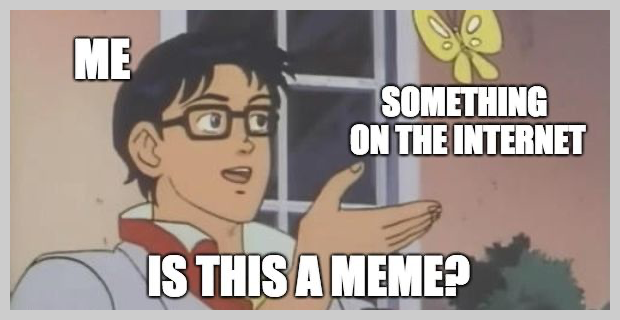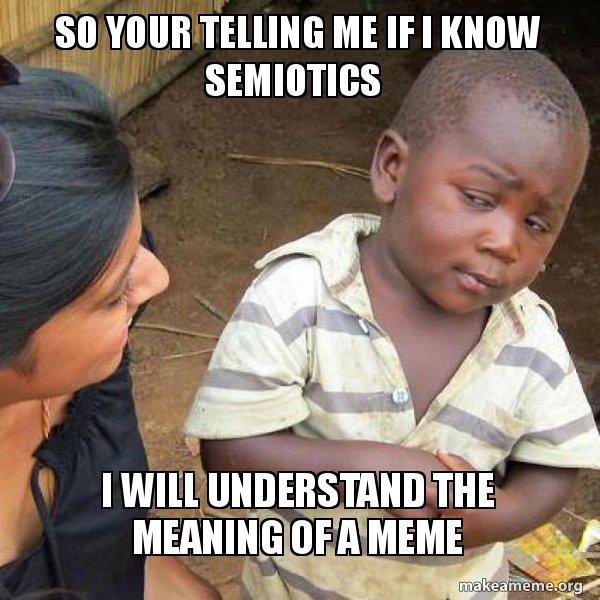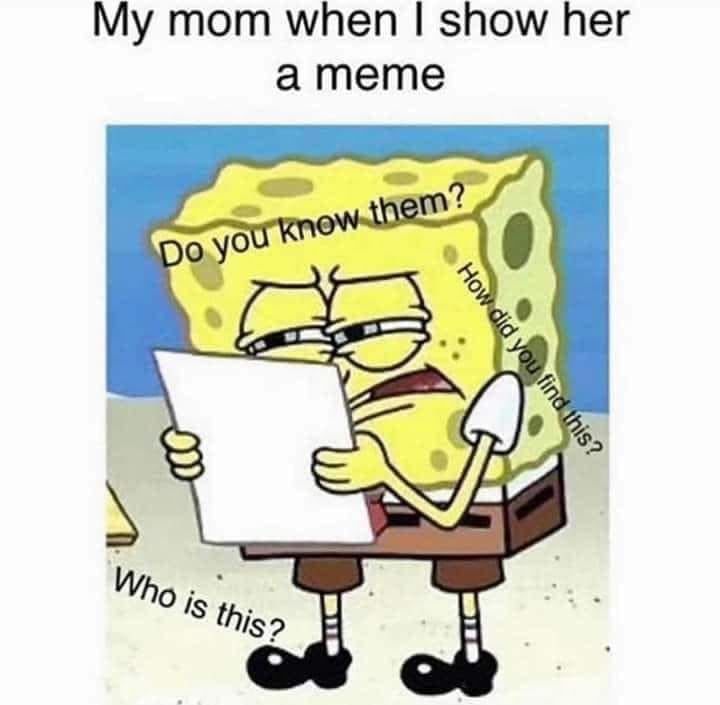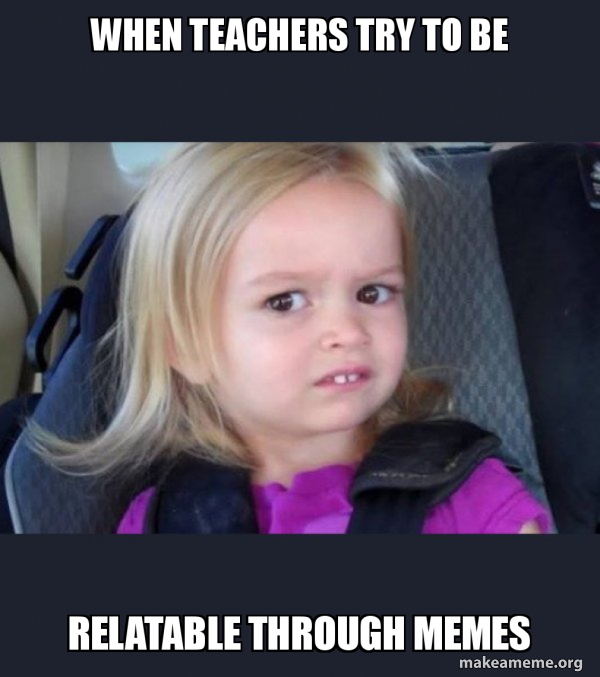Memes: A New Approach to Digital Literacy and Learning
The Meme: More than a Funny Picture
 Internet culture has radically changed our approach to digital literacy. The perpetually changing landscape demands digital citizens require more than technical knowledge. Users navigating the online world, particularly the social subset, need to be considerate of customs, mannerisms, and practices. The social subset of the internet includes social networking platforms like Twitter, Instagram, and Reddit where users can participate in online discourse. Among the varied forms of interactive media on these social platforms, is the meme. At first glance, the meme is a humorous photo, likely a satirical interpretation of a situation or experience. But, upon deeper investigation, the meme is layered with semantic value and intertextuality. Arguably, the meme is underutilized in formal education and classrooms – often being seen as entertainment rather than a text. Evidently, students require critical media literacy and memetic analysis skills to be empowered to navigate their technocratic world.
Internet culture has radically changed our approach to digital literacy. The perpetually changing landscape demands digital citizens require more than technical knowledge. Users navigating the online world, particularly the social subset, need to be considerate of customs, mannerisms, and practices. The social subset of the internet includes social networking platforms like Twitter, Instagram, and Reddit where users can participate in online discourse. Among the varied forms of interactive media on these social platforms, is the meme. At first glance, the meme is a humorous photo, likely a satirical interpretation of a situation or experience. But, upon deeper investigation, the meme is layered with semantic value and intertextuality. Arguably, the meme is underutilized in formal education and classrooms – often being seen as entertainment rather than a text. Evidently, students require critical media literacy and memetic analysis skills to be empowered to navigate their technocratic world.
The Meme: Situated in Historical and Contemporary Media
The meme, as first defined by Richard Dawkins in 1976, “describes small units of culture that spread from person to person by copying or imitation” (Shifman, 2013, p.2). The meme is not the first form of literacy that has developed through imitation and that has produced such prolific virality. However, the decentralized and highly unregulated production finds itself in a niche in modern culture. The practice of copying and editing pre-existing memes is what facilitates the efficiency and rapid speed of the dissemination process.
The social logic of memetic communication as described by Barry Wellman et al. is networked individualism (2003). Creators are producing independently while engaging with the demands of their community. The inherent qualia of the meme come from its communicability and participatory culture, that is to say, for an individual to understand a meme, they need to understand far more than the words or the images readily displayed. Memes are a method of self-expression that allows internet users to share their thoughts, feelings, ideas, and values. Further, “internet memes depend on collective creation, circulation, and transformation. They’re multimodal texts that facilitate participation by reappropriation, by balancing a fixed premise with novel expression” (Milner, 2016, p.15). The format of the meme is reduced to include limited verbiage and almost no direct contextual information. Consequently, the combination of image and text can have nuanced references that require both the creator and viewer to extrapolate meaning.

(Hernández Cuevas, 2021)
In the early 2000s, Web 2.0 paved the opportunity for user-exchanged platforms to proliferate content, practicing unrestrained mimicry (Shifman, 2013, p.18). Initially, the most common memes were of animals, oftentimes cats. However, the memetic content expanded and began to dominate mainstream culture, including more images of celebrities or public figures. Consequently, many subcultures adopted the memetic process, and the form of communication became normalized on most social networking platforms. Meme accounts quickly became some of the most popularized accounts on leading social media platforms, which further led to the rise in memetic engagement.

@fuckjerry (2023)
An example of a meme account with a far-reaching audience is, “@fuckjerry.” The founder, Elliot Tebele, started posting memes in 2011 as a hobby. However, in an interview with Forbes magazine in 2017 he stated, “We have over 40 million followers on our social media channels, and have very serious intentions of creating one of our generation’s most meaningful media companies.” Also adding that @fuckjerry later transformed into Jerry Media, a media organization with over 20 staff (Forbes, 2017). Meme accounts have developed into multi-million dollar companies that have significant direct user outreach and engagement. Currently, the @fuckjerry Instagram account alone has 17 million followers (fuckjerry, 2023), attesting to the increase in general user participation and overall popularity of memes. These accounts demonstrate that memes have become a key component of internet culture, and culture more broadly.
While the organizational infrastructure for meme creation and production has changed, so has the media landscape. The period between 2012 – 2016 was a revolutionary time for the meme; political and digital spheres began to overlap and the internet saw an uptick in political participation on social media (Denisova, 2020). Unsurprisingly, memes were introduced to the political conversation. Creators started using memes to make social commentary on complex socio-political topics, like political candidacies and global warming. In many ways, this was the period where the meme transformed into a rhetorical text.
The Meme: Political Participation 
Political memes are far more than just funny pictures, they are participating in politics by creating rhetorically persuasive political arguments and engaging in political conversations. While there is limited research on the informal educational impacts of memes and/or their effectiveness in unmediated learning, there is a well-documented correlation between memes and political engagement from youths. Within the last decade, there has been an increase in youth political engagement due to the shift away from traditional media.
Participatory practices among youth include re-posting, sharing, and commenting on posts of political memes – ultimately indicating that memes are texts that prompt political conversation. In our current attention economy, traditional news and media outlets are fighting for the attention of young adults (Ireland, 2018, p.123). With easy, quick access to information on social media, many young adults are reporting that social media is their primary source of news. Young adults are using memes to piece together their social world, they “have become part of the cultural lexicon, and students are sure to encounter political memes on a regular basis, likely more often than they read traditional news sources” (Journell, 2019, p.109). In previous decades, more traditional methods of political engagement included voting and joining political affiliations. Limor Shiftman writes in his book, Memes in Digital Culture
“In recent years the perception of what constitutes political participation has been broadened to include mundane practices, such as commenting on political blogs and posting jokes about politicians. To a large extent, this transformed the perception of what counts as political participation is tied to the rise of the Internet and other digital media…New media offer appealing and convenient ways to stimulate participatory activity, especially among younger citizens who have been the least likely to participate in formal politics” (Shifman, 2013, p.178)
The social media era has structurally changed communication practices to envelope new means of mobilizing political movements and encouraging collective engagement. In other words, young adults are using political memes to connect and share insight into their beliefs and values.
Changing Social Constructs One Meme at a Time
 Ryan M. Milner shares in his book, The World Made Meme: Public Conversations and Participatory Media, “the collectivism and reappropriation foundational to memetic participation can both facilitate and critique hegemony, as multiple participants embrace memetic logics for multiple ends” (p. 145). Constantly reinterpreting and reproducing allows the meme to be a digital artifact that both symbolizes and forms social constructs. Memes can capture social commentary, while also contributing to a larger social narrative. Media researchers suggest that memes are effective tools for narration and info-sharing, essentially being “pieces of cultural information that pass along from person to person, but gradually scale into a shared social phenomenon” (Shifman, 2013, p.18).
Ryan M. Milner shares in his book, The World Made Meme: Public Conversations and Participatory Media, “the collectivism and reappropriation foundational to memetic participation can both facilitate and critique hegemony, as multiple participants embrace memetic logics for multiple ends” (p. 145). Constantly reinterpreting and reproducing allows the meme to be a digital artifact that both symbolizes and forms social constructs. Memes can capture social commentary, while also contributing to a larger social narrative. Media researchers suggest that memes are effective tools for narration and info-sharing, essentially being “pieces of cultural information that pass along from person to person, but gradually scale into a shared social phenomenon” (Shifman, 2013, p.18).
In essence, memes are used to spread beliefs and ideas through micro-interactions that cumulatively have large impacts on a meso and macro level. As texts, they influence perspectives, and “shape the mindsets, forms of behavior, and actions of social groups” (Shifman, 2013, p.18). Filled with semiotic meaning and value, they are layered with complexities that both sustain and refute cultural norms, expectations, and binaries.
The Participatory Gap for Memetic Literacy

The layers of unspoken complexity make memes challenging to understand and decipher. Participation in meme culture is based on a person’s ability to interpret the meme’s limited information and draw connections to ideas using its signs and symbols. Structurally, memes are dependent on intertextual references and participatory culture, meaning readers can face a knowledge gap. It’s nearly expected that all readers, to some degree, are unable to read some memes – as the scope of subjects is limitless and surely one person can’t know everything. However, reading a meme takes practice and requires a unique form of literacy. McChulloh writes in her text Because Internet,
“Some have a sophisticated knowledge of internet culture and social media strategy, and have made memes or accounts seen by millions of people; some don’t know how to write an informative email subject line…This high degree of variance, both within and between Post Internet People, tends to be the hardest thing for their parents and teachers to grasp” (McCulloh, 2019, p.102)
Digital literacy has moved past rudimentary tech skills, like sending an email. As the internet has become a more complex space, so have the faculties required to successfully navigate and thrive in a digital environment. Memetic literacy requires a reader to understand the social structure sustaining the integrity of its meaning, as well as demands that readers have the critical media literacy to be able to critically question its intention, purpose, and underlying biases.
Memes as Educational Texts

In classrooms and formal education, memes are frequently used to create relatability, either between the teacher and the students, or the students and the topic. In most cases, memes are frequently used in the classroom as a playful engagement tactic rather than introduced as an argumentative text. Due to their humorous nature, memes are often disregarded, “[they] have been underutilized as rich textual resources applicable to classroom scrutiny” (Coleman et al. 2019, p.30). However, given the impactful and powerful role memes play in social and political narratives, young adults should be equipped to deconstruct a meme’s semiotic meaning and determine the media’s influence on their own perspective and identity.
In the article titled, “#NeverthelessMemesPersisted: Building Critical Memetic Literacy in the Classroom,” Harvey and Palese argue that “Critical memetic literacy is.. an essential tool that our students need to help them navigate the Internet and their media lives. By helping them recognize the processes that go into meme (re)creation and consumption, students gain a broader awareness of some of the invisible forces at work in society at large” (2018). Students need to be given the tools to better understand how the media they consume frequently is shaping their world, both online and offline. Memetics will continue to be fluid, dynamic, and shaping literacy; therefore further research in the field of memetics and education should be explored.
References
Denisova, A. (2020). Internet memes and Society: Social, cultural, and political contexts. Routledge, Taylor & Francis Group.
Elmore, P. G., & Coleman, J. M. (2019). Middle school students’ analysis of political memes to support critical media literacy. Journal of Adolescent & Adult Literacy, 63(1), 29–40. https://doi.org/10.1002/jaal.948
fuckjerry [@fuckjerry]. (2023). Jerry Media [Instagram profile]. Instagram. Retrieved from https://www.instagram.com/fuckjerry/?hl=en
Hernández Cuevas, E. M. (2021). The Importance of Studying Memes in the Social Sciences .
Harvey, L., & Palese, E. (2018). #neverthelessmemespersisted: Building critical memetic literacy in the classroom. Journal of Adolescent & Adult Literacy, 62(3), 259–270. https://doi.org/10.1002/jaal.898
Ireland, S. (2018). Fake news alerts: Teaching news literacy skills in a meme world. The Reference Librarian, 59(3), 122–128. https://doi.org/10.1080/02763877.2018.1463890
Mandiberg, M. (2012). The Social Media Reader. New York University Press.
McCulloch, G. (2019). Because internet: Understanding the new rules of language. Riverhead Books.
Milner, R. M. (2016). The world made meme: Public conversations and Participatory Media. The MIT press.
Shifman, L. (2013). Memes in digital culture. CRC Press.
Ward, T. (2017, July 18). Who the F is Jerry? an interview with f—jerry’s founder Elliot Tebele. Forbes. Retrieved from https://www.forbes.com/sites/tomward/2017/07/17/who-the-f-is-jerry-an-interview-with-f-jerrys-founder-elliot-tebele/?sh=15fd9613da41
Wellman, B., Quan-Haase, A., Boase, J., Chen, W., Hampton, K., Díaz, I., & Miyata, K. (2006). The social affordances of the internet for networked individualism. Journal of Computer-Mediated Communication, 8(3). https://doi.org/10.1111/j.1083-6101.2003.tb00216.x